

Bob Whitehead interview
By Scott Stilphen
(2005)
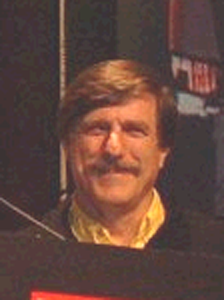
As one of the original Atari VCS programmers hired at Atari, he created some of the first sports and casino games for that system (along with 2 of the most influential programming tricks ever invented) before taking a ‘gamble’ and leaving Atari for greener pastures at Activision. His hitting streak continued with more ground-breaking sports games, helping Activision to ‘stampede’ over their competitors. When the industry crash of the mid-80s hit, he left to join the starting line-up at Accolade, enabling his career to go into ‘extra innings’.
Q: What’s your educational background?
Bob Whitehead: BS, Mathematics (emphasis in Computer Mathematics), San Jose State University.
Q: What inspired you to go into game design?
Bob Whitehead: It sure beats programming for a Department of Defense Contractor.
Q: How did you hear about Atari? When did you start working for them?
Bob Whitehead: I was hired in January, 1977, as one of Atari’s first programmers for their new programmable game machine, the VCS 2600, by Bob Brown, who only months before had left as my boss at a Department of Defense Contractor for Atari.

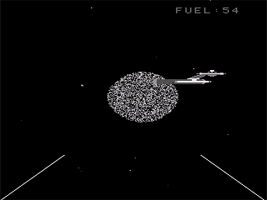
Atari VCS Star Ship (left); Atari coin-op Starship 1 (right).
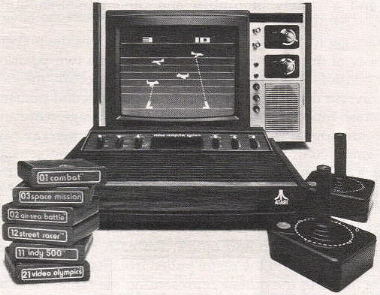
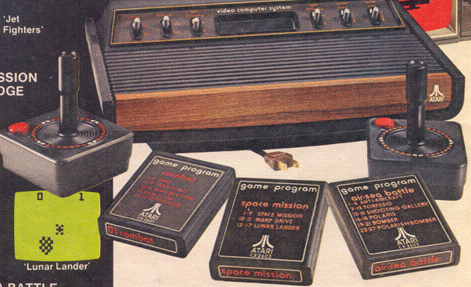
Early Atari ads showing Star Ship with its original title, Space Mission. It was introduced at the 1982 CES in June under that name.
Q: Star Ship was your first game with Atari, which featured an innovative 1st-person perspective, and was the first game to use registers as general RAM storage (giving you 3 more bits of RAM). This was a port of Atari’s Starship 1 coin-op (which was released in July 1977 - one month after Star Ship was first shown at the 1977 Summer CES). Early Atari ads showed Star Ship titled as Space Mission. Was this the original name for it? And if so, do you recall why it was changed seemingly right before release?
Bob Whitehead: Beats me. Using the arcade title made a lot more sense. I didn’t have a direct line to the marketing department and they didn’t exactly consult us programmers themselves.
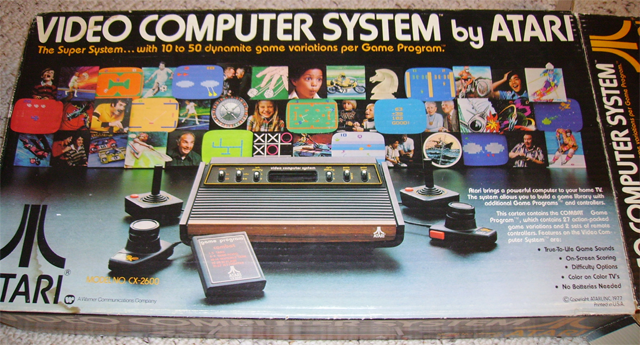
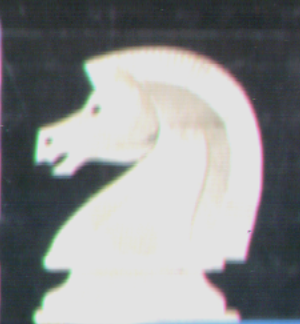
Original VCS system box (1977) showing the chess piece artwork
Q: According to Larry Wagner, Video Chess was developed as a direct result of a customer who complained that the (original) VCS system box showed a picture of chess, but that no chess game existed. Did this person actually sue Atari over that (and if so, did they win)? How difficult was the development process, and where did the idea for the “Venetian blinds” technique originate?
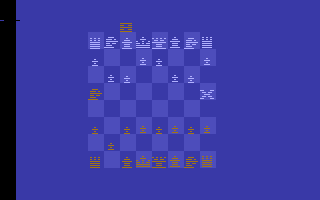 Bob Whitehead: Box art has always been a problem in our industry. How do you communicate to
a consumer what’s inside, at the same time sell an image and make it “pop” on the self. Combine that with a marketing group who’s not experienced in consumer electronics and you’ve got trouble. Consumer electronics, unlike many “Procter and Gamble” type products, is a business selling to a very savvy bunch of patrons. Plus at the time, the computer chess game segment was an important genre in the very early stages of the home computer gaming business. Atari felt they had
to address it. Unfortunately, those games at the time were simple text driven interfaces with no graphics, and putting “chess pictures” on the box didn’t strike the powers-to-be how difficult a task it would be to pull off. I do remember discussions in the lab of how “stupid” it was to assume we can do a chess game and how “impossible” it was to do. And that’s all I needed … you see the word “impossible,” it seems, has always been one of my “igniters” - it gets the puzzle
solver in me going.
Bob Whitehead: Box art has always been a problem in our industry. How do you communicate to
a consumer what’s inside, at the same time sell an image and make it “pop” on the self. Combine that with a marketing group who’s not experienced in consumer electronics and you’ve got trouble. Consumer electronics, unlike many “Procter and Gamble” type products, is a business selling to a very savvy bunch of patrons. Plus at the time, the computer chess game segment was an important genre in the very early stages of the home computer gaming business. Atari felt they had
to address it. Unfortunately, those games at the time were simple text driven interfaces with no graphics, and putting “chess pictures” on the box didn’t strike the powers-to-be how difficult a task it would be to pull off. I do remember discussions in the lab of how “stupid” it was to assume we can do a chess game and how “impossible” it was to do. And that’s all I needed … you see the word “impossible,” it seems, has always been one of my “igniters” - it gets the puzzle
solver in me going.
As for lawsuits, I don’t remember anything like that. Venetian blinds came about like any other programming technique. Building and improving on the previous technique with some insight is my first answer to your question. But a better answer is, “just being driven to want more visually,” a distinctive motivator, I think, of the gamer’s mind. A very critical feature of the architecture of the Atari 2600 was the hardware designer’s decision to put the graphic display power in the hands of the programmer. Really, once the programmer understood that almost everything in the graphics chip could be “changed on the fly,” techniques began to evolve as the necessities of invention drove the process. It usually is the case even today, the software guys know more about a system’s capabilities than the hardware guys could ever dream of knowing. And there is the programmer in me who misses the direct access to the hardware in today’s machines.
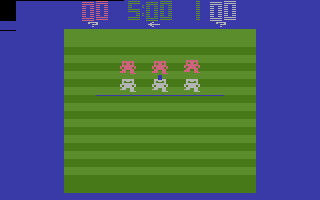
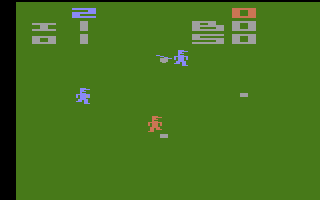
Football (left) and Home Run (right)
Q: You did the 1st versions of baseball and football for the VCS (Home Run and Football respectively). Back in 1978, there was an interview in the New York Times with Nolan Bushnell. In it, he mentioned there was a story about one of them (possibly Home Run) in which the game had to be reprogrammed at one point because it didn’t exactly follow the rules of the sport. To quote - "Mr. Bushnell recalled that the video game Home Run was originally assigned to an engineer who didn't know the rules of baseball. As a result, he created a game in which a batter who swung at a ball and missed was credited with a ball instead of a strike. The mistake has since been corrected." Do you recall this being the case, or was it just a simple mistake that you caught and fixed?
Bob Whitehead: What could have happened was that Nolan got a beta version (EPROM version). It was common back then to disperse EPROM versions for testing and to give the rest of the company a look at a "not quite yet final" version. And nothing is more exhilarating and ego-boosting than to find a bug. I still get off on it, and even to this day have a knack for it. I don’t remember reprogramming any of my games once they were released, or even after an alpha or beta (early playing version) version. Yes, tweaking playability and fixing bugs just before release dictated a few changes, but they were usually minimal until release. Once released, there were no bugs, only “features”. I was careful and fortunate enough to avoid any debilitating bugs in any of my releases.
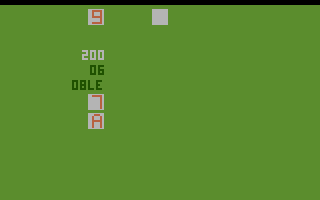
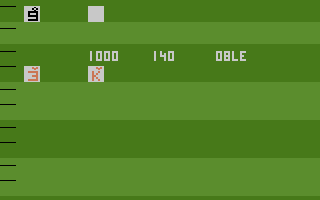
Blackjack (left) and Casino (right)
Q: Blackjack was the first game to rewrite copied player graphics on the fly, which was a major breakthrough! This led to the development of the first moving 6-character object (with David Crane's Dragster) and the first 6-digit score counter (with David Crane's Laser Blast). How did the superior sequel, Casino (which may have been the first ‘sequel’ game for the VCS) come about?
Bob Whitehead: If I remember right, Casino really became my design goal somewhere in the middle of Blackjack, but I released Blackjack for the short term - it was important to pump out product! Also, if my memory serves me right, Casino was a larger size ROM (more expensive part), which played a factor (Ed: Blackjack is 2K, whereas Casino is 4K).
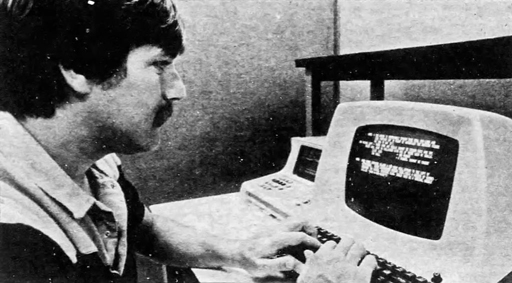
Bob Whiltehead working on a development
station at Activision circa 1982.
Q: At Activision, you helped design the development system that was used to program all of their games. Can you explain a bit about its creation and how it worked?
Bob Whitehead: Dave Crane, with some help from some simple reverse engineering and a little input from Al Miller, designed the hardware, and I wrote the debugger software. Simply, it was a ROM simulator with a RS-232 terminal interface which plugged into an Atari cartridge slot. You would download an assembled (object code) program and then run it in a simple debugging environment. The system needed a cross-compiling and source editing environment provided by a mini-computer to assemble the program. A “dumb terminal” was used as the interface to the development system and the mini-computer.
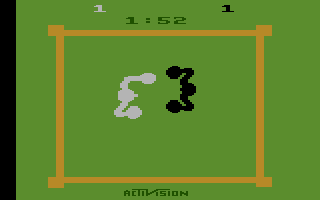
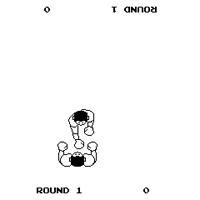
Boxing (left) was based on an unreleased Atari coin-op game called Boxer (right)
Q: Your first 2 titles there were sports games – Boxing and Skiing. I suppose it goes without saying that you’re quite a sports fan! Were there any that you actively played? Were these game ideas ones you had planned on doing at Atari?
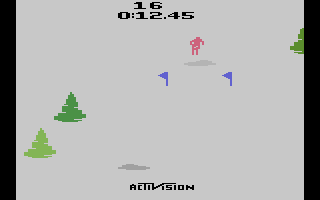 Bob Whitehead: I, like many kids growing up, was an athlete “want-a-be” with some athletic ability (but no real talent), so I dabbled in them all. Sports are my personal fantasy
and (as all good game designers should) I started there, but to answer your question, no. I guess I’m not so visionary, as I’ve never had a 5 year game design plan, nor have I ever thought much past my current project. Once a game is finished, I go through a little withdrawal, figure out what makes sense to do next, and dive into the next project.
Bob Whitehead: I, like many kids growing up, was an athlete “want-a-be” with some athletic ability (but no real talent), so I dabbled in them all. Sports are my personal fantasy
and (as all good game designers should) I started there, but to answer your question, no. I guess I’m not so visionary, as I’ve never had a 5 year game design plan, nor have I ever thought much past my current project. Once a game is finished, I go through a little withdrawal, figure out what makes sense to do next, and dive into the next project.
Q: Chopper Command seems obviously inspired by Defender, but the result is a much more attractive and cleaner display than Atari’s version. I’ve always been impressed by the fact that Activision could essentially take a similar game and do it better than Atari’s own version (ex. Night Driver – Enduro; Battlezone
– Robot Tank; etc).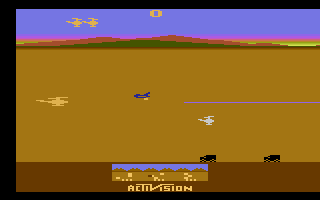
Bob Whitehead: It’s the difference between ownership and hired “towel designers” (that was a derogatory label given to Atari’s programmers by its president, Ray Kassar, who had come from Ralph Lauren, which meant to us “run of the mill, creative talent”). It was our company and we took it personal. Setting the bar high was the only way, and the competitive spirit flowed though our veins.
Q: With Stampede, I’ve heard that an early version of this exists (called Rodeo), and that it possibly was started while you were at Atari. Are either of these rumors true?
Bob Whitehead: No. Ah, the dark side of competition, jealousy and lies (Ed: this rumor likely started over the planned Stampede clone for the Interton VC4000 system, which was titled Rodeo).
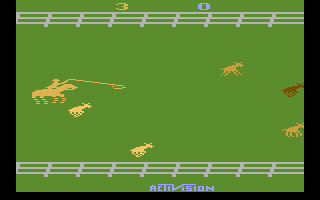
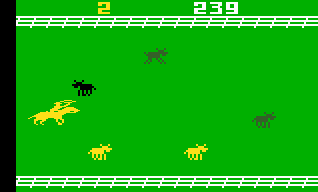
Atari VCS (left) and Intellivision (right) versions of Stampede

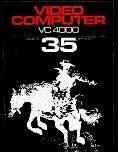
Box artwork for the unreleased Interton VC4000 Rodeo
Q: I noticed that VCS Stampede also makes use of your Venetian blinds trick. Although this was used in several games at Atari (such as Football, Polo, and Space Invaders), it was also used by other companies, besides Activision. According to David Crane, it also played a part in Atari’s lawsuit against Activision, which led to him creating the now-famous Venetian blinds demo. Did the fact that Stampede used this programming trick prompt Atari to file their lawsuit, or was it a matter of them pre-empting any use of it by others?
Bob Whitehead: Lawsuits are used by big companies to limit competition even though its legal merits are few. And unfortunately, it works.
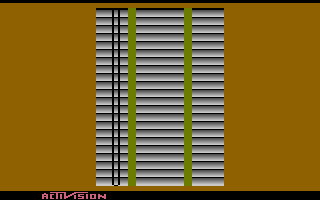
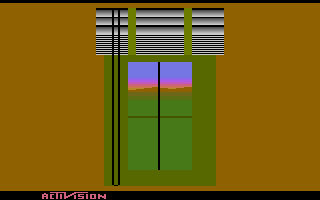
Q: Although not all of Atari's lawsuits were frivolous or baseless (in a lot of cases they were simply protecting their property - the case against Odyssey 2's K.C. Munchkin being a good example) but to go after companies who want to make software for their systems... that just shows how short-sighted Kassar really was. The suit against Activision though seemed more 'spiteful' than any other case they initiated. It makes for a very interesting "what if" scenario, if they had been successful...
Bob Whitehead: Don't get me wrong! I am a business man, too. And intellectual property rights are important to protect, as well as that discovery process of finding out if you have a case or not. But there is also the intimidation process that occurs with customers and consumers you compete for, that flirts with the dark side of business ethics. If you can label a competitor as a
"thief," even for a short 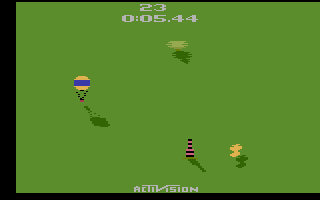 time, it gives you a distinct advantage. Some of the intimidation tactics of our customers were not always so subtle. It tests your competitive skills.
time, it gives you a distinct advantage. Some of the intimidation tactics of our customers were not always so subtle. It tests your competitive skills.
Q: Sky Jinks is very much like a “reverse” Skiing with improved visuals and gameplay. It’s hard to believe that they’re both the same size (2K)! It also uses your Venetian blinds trick in a very subtle way. Was this used in any other Activision games?
Bob Whitehead: The Venetian blind technique is a very simple visual implementation of the general technique of repositioning the sprites (or high resolution graphic stamps) and displaying them on the next line or later on in the screen, giving the appearance that the hardware has more than 2 sprites. In a general sense all the Activision games used this technique with more and more frequency and skill as time went on.
Q: Your last VCS game, Private Eye, was a real visual treat. The display and game design really showed your 7+ years of experience! What was the inspiration for this game?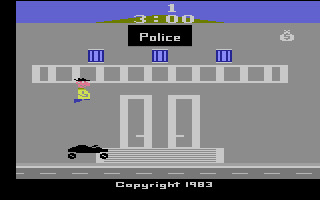
Bob Whitehead: Fantasy, once again. Everyone loves a mystery.
Q: You left Activision, along with Al Miller, to start Accolade. What was happening at Activision at that point that caused all the founders to leave within a few years? I was always under the impression that the four of you (David, Alan, Larry, and yourself) owned Activision, along with perhaps Jim Levy…
Bob Whitehead: We owned stock, Jim had a little more than us designers, but the VC’s got the controlling interest. We were insiders, so selling stock was a no-no, but the market had turned and our stock was a tenth of what it was… and moral wasn’t so good. We felt that diversification was a big part of the problem and computers, such as the C-64, were a growing segment. And we weren’t naive kids anymore - opportunity knocked!
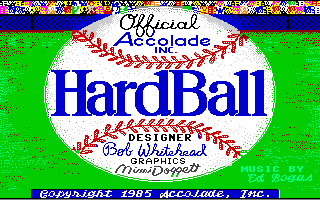
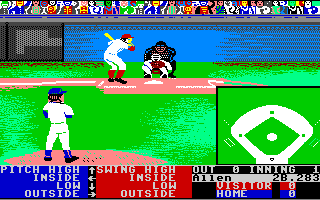
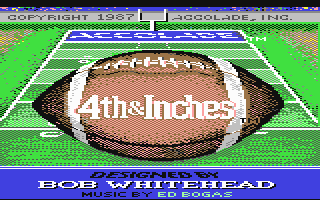
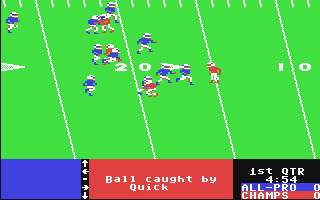
Q: At Accolade you developed 2 titles (for the C-64) - HardBall and 4th & Inches. I doubt that any other VCS programmer has done as many sports titles, so it’s not surprising (but ironic) that your first 2 sports titles were again baseball and football! It’s also amazing to see how progressive Hardball is to Home Run. Was the look and perspective of these games influenced by any earlier titles, such as Colecovision’s sports games?
Bob Whitehead: No, by watching TV! Understand my job as a game designer is to bring freshness to some familiar fantasy. The perspective of Hardball is just a reproduction of the very familiar centerfield camera, which was the first game to use that (Ed: Colecovision's Super Action Baseball preceded HardBall by 2 years, but the perspective was more from the angle of the dugout).
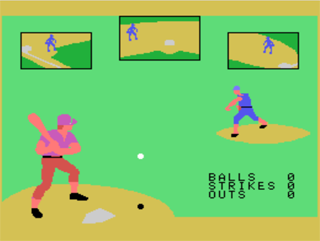
Colecovision's Super Action Baseball
Q: After you became VP of Product Development at Accolade, you no longer did any game design/programming. Did you ever consider getting back into game design/programming? Lately it seems a number of former 2600 programmers have gravitated to web-based or cell-based game design…
Bob Whitehead: The casual gaming cell-based business has been getting the juices flowing again.
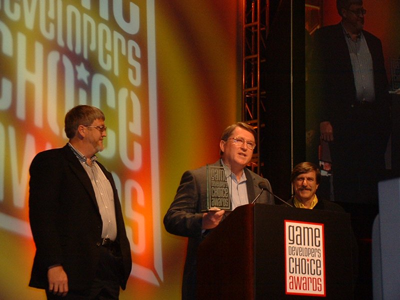
Receiving some well-deserved ‘accolades’ at the 2003 Game Developer’s Conference, along with David Crane and Alan Miller
Q: Can you describe your career, between Accolade and now, and why you left the video game industry?
Bob Whitehead: I would consider myself a driven man, business-wise. Yet, I never considered myself very ambitious on the personal side. And I like new challenges, too. Even though I seemed to be very focused on the start-ups back then, my God and my family, still, were prime. I had some success (it’s never enough), but it was time to give back to God and spend time with “the fam”. Helping personally with low income families, getting non-profit religious start-ups going, spending time in the garden, and staying under the radar has consumed much of my time in the last decade or so.
Q: Were there any games that you started, but didn't finish or get released? Also, do you recall any other titles that others were working on but weren't released?
Bob Whitehead: It seems I always finished what I started.
Q: Were the games that you wrote ones that were chosen or assigned?
Bob Whitehead: No game titles were ever assigned me. Even though I had full control over what I did next I don’t remember ever doing a game where pier influence and input from the business side didn’t play a role. I look at myself as team player.
Q: Are there Easter eggs in any of your titles?
Bob Whitehead: No. I’m not the hacker type.
Q: Do you still own any of your games for these systems?
Bob Whitehead: Yes, I've got a few around, although I'm still going through the base units. I've had to replace a few. Thank goodness there are still some around at these swap meets and on eBay.
Q: Which of your titles are your favorite, and what games in general?
Bob Whitehead: I’m most proud of Stampede and Hardball. One of my all-time classic favorites is Missile Command.
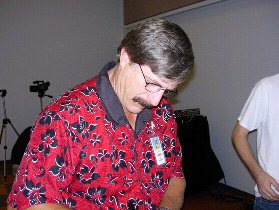 Q: Outside of shows like CGE, do you ever see any of your former, fellow 2600 programmers?
Q: Outside of shows like CGE, do you ever see any of your former, fellow 2600 programmers?
Bob Whitehead: Occasionally I’ll catch someone at the Game Developers Conference. But it is a “senior moment” when I run into one of their kids.
Q: What are your thoughts on how the industry has evolved?
Bob Whitehead: Too dark and derivative for my taste. The console and computer gaming business is too narrowly-defined by the 14-year-old male mentality and all his not-so-honorable fantasies. It's being driven by what has worked and afraid of what a 10 million dollar development bust will entail. It has lost its moral compass.
Q: You're not alone in that assessment, but can you foresee a time when the industry will turn its main focus back onto the general casual-gaming public again?
Bob Whitehead: The wireless cell phone business is forcing the issue since half the audience is female. I really like the creative challenge of looking at a different audience, although you will still see the old Bob in my titles going forward, too. I'm no fool.
Here's Atari's commercials for Bob Whitehead's Atari VCS/2600 Home Run (featuring Pete Rose), Star Ship, and Blackjack (featuring Carol Channing) games:
Here's Activision's 1981 "Video Update" promotional video featuring Bob Whitehead, David Crane, Alan Miller, Larry Kaplan, and Jim Levy. Also shows the commercials for Laser Blast and Skiing, and video footage of Stampede, Ice Hockey, Boxing, Dragster, Bridge, Fishing Derby, Checkers, Tennis, Freeway, and Kaboom!
Here's Activision's 1982 promotional video featuring Alan Miller, Larry Kaplan, Bob Whitehead, David Crane, Steve Cartwright, and Jim Levy. Also shows video footage of Tennis, Skiing, Laser Blast, Ice Hockey, Kaboom!, Stampede, Freeway, Barnstorming, Grand Prix, Chopper Command, and Starmaster.
Here's the Activision commercials for Bob Whitehead's Atari VCS/2600 games Skiing, Stampede, and Chopper Command:
Here's the Activision commercial for Bob Whitehead's Mattel Intellivision Stampede game (featuring Earl Boen):
| GAME | SYSTEM | COMPANY | STATUS |
| Home Run | Atari VCS/2600 | Atari | released |
| Football | Atari VCS/2600 | Atari | released |
| Blackjack | Atari VCS/2600 | Atari | released |
| Casino | Atari VCS/2600 | Atari | released |
| Star Ship | Atari VCS/2600 | Atari | released |
| Video Chess | Atari VCS/2600 | Atari | released |
| Boxing | Atari VCS/2600 | Activision | released |
| Skiing | Atari VCS/2600 | Activision | released |
| Stampede | Atari VCS/2600 | Activision | released |
| Chopper Command | Atari VCS/2600 | Activision | released |
| Sky Jinks | Atari VCS/2600 | Activision | released |
| Private Eye | Atari VCS/2600 | Activision | released |
| Stampede | Intellivision | Activision | released |
| Hardball | C-64 | Accolade | released |
| 4th & Inches | C-64 | Accolade | released |